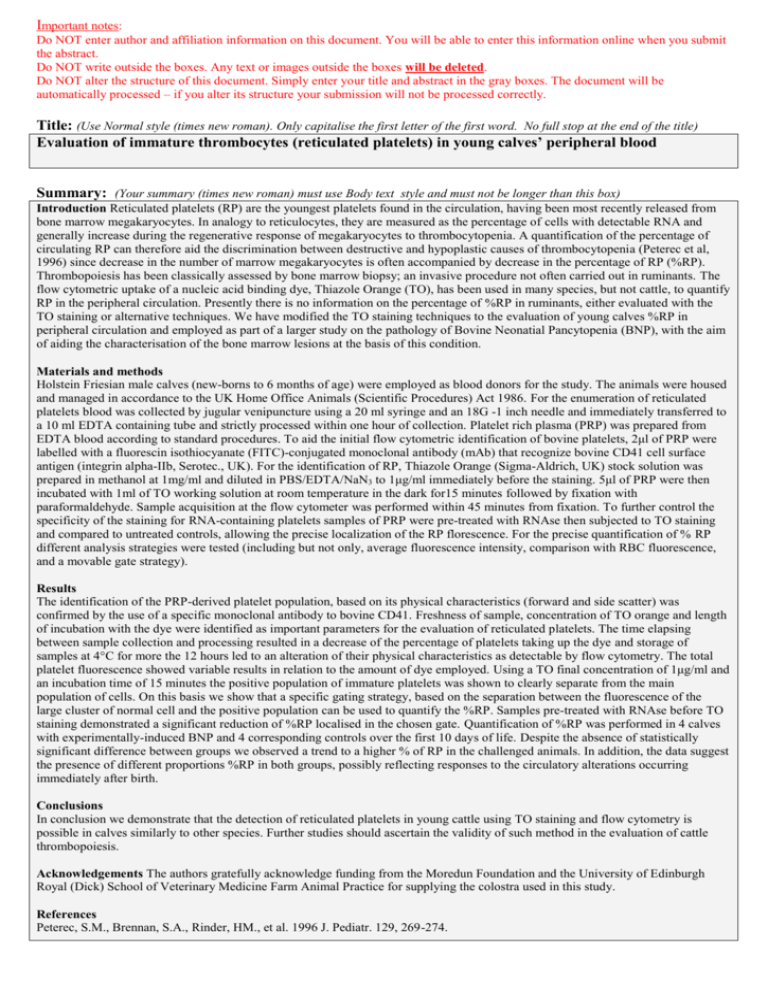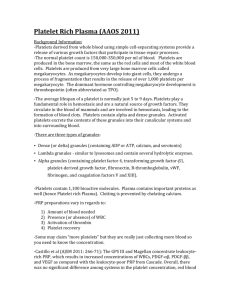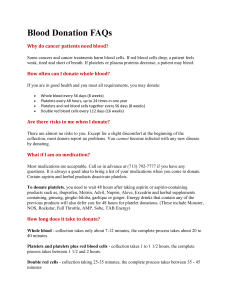BSAS_abstract_MR_platelets
advertisement

Important notes: Do NOT enter author and affiliation information on this document. You will be able to enter this information online when you submit the abstract. Do NOT write outside the boxes. Any text or images outside the boxes will be deleted. Do NOT alter the structure of this document. Simply enter your title and abstract in the gray boxes. The document will be automatically processed – if you alter its structure your submission will not be processed correctly. Title: (Use Normal style (times new roman). Only capitalise the first letter of the first word. No full stop at the end of the title) Evaluation of immature thrombocytes (reticulated platelets) in young calves’ peripheral blood Summary: (Your summary (times new roman) must use Body text style and must not be longer than this box) Introduction Reticulated platelets (RP) are the youngest platelets found in the circulation, having been most recently released from bone marrow megakaryocytes. In analogy to reticulocytes, they are measured as the percentage of cells with detectable RNA and generally increase during the regenerative response of megakaryocytes to thrombocytopenia. A quantification of the percentage of circulating RP can therefore aid the discrimination between destructive and hypoplastic causes of thrombocytopenia (Peterec et al, 1996) since decrease in the number of marrow megakaryocytes is often accompanied by decrease in the percentage of RP (%RP). Thrombopoiesis has been classically assessed by bone marrow biopsy; an invasive procedure not often carried out in ruminants. The flow cytometric uptake of a nucleic acid binding dye, Thiazole Orange (TO), has been used in many species, but not cattle, to quantify RP in the peripheral circulation. Presently there is no information on the percentage of %RP in ruminants, either evaluated with the TO staining or alternative techniques. We have modified the TO staining techniques to the evaluation of young calves %RP in peripheral circulation and employed as part of a larger study on the pathology of Bovine Neonatial Pancytopenia (BNP), with the aim of aiding the characterisation of the bone marrow lesions at the basis of this condition. Materials and methods Holstein Friesian male calves (new-borns to 6 months of age) were employed as blood donors for the study. The animals were housed and managed in accordance to the UK Home Office Animals (Scientific Procedures) Act 1986. For the enumeration of reticulated platelets blood was collected by jugular venipuncture using a 20 ml syringe and an 18G -1 inch needle and immediately transferred to a 10 ml EDTA containing tube and strictly processed within one hour of collection. Platelet rich plasma (PRP) was prepared from EDTA blood according to standard procedures. To aid the initial flow cytometric identification of bovine platelets, 2μl of PRP were labelled with a fluorescin isothiocyanate (FITC)-conjugated monoclonal antibody (mAb) that recognize bovine CD41 cell surface antigen (integrin alpha-IIb, Serotec., UK). For the identification of RP, Thiazole Orange (Sigma-Aldrich, UK) stock solution was prepared in methanol at 1mg/ml and diluted in PBS/EDTA/NaN3 to 1μg/ml immediately before the staining. 5μl of PRP were then incubated with 1ml of TO working solution at room temperature in the dark for15 minutes followed by fixation with paraformaldehyde. Sample acquisition at the flow cytometer was performed within 45 minutes from fixation. To further control the specificity of the staining for RNA-containing platelets samples of PRP were pre-treated with RNAse then subjected to TO staining and compared to untreated controls, allowing the precise localization of the RP florescence. For the precise quantification of % RP different analysis strategies were tested (including but not only, average fluorescence intensity, comparison with RBC fluorescence, and a movable gate strategy). Results The identification of the PRP-derived platelet population, based on its physical characteristics (forward and side scatter) was confirmed by the use of a specific monoclonal antibody to bovine CD41. Freshness of sample, concentration of TO orange and length of incubation with the dye were identified as important parameters for the evaluation of reticulated platelets. The time elapsing between sample collection and processing resulted in a decrease of the percentage of platelets taking up the dye and storage of samples at 4°C for more the 12 hours led to an alteration of their physical characteristics as detectable by flow cytometry. The total platelet fluorescence showed variable results in relation to the amount of dye employed. Using a TO final concentration of 1μg/ml and an incubation time of 15 minutes the positive population of immature platelets was shown to clearly separate from the main population of cells. On this basis we show that a specific gating strategy, based on the separation between the fluorescence of the large cluster of normal cell and the positive population can be used to quantify the %RP. Samples pre-treated with RNAse before TO staining demonstrated a significant reduction of %RP localised in the chosen gate. Quantification of %RP was performed in 4 calves with experimentally-induced BNP and 4 corresponding controls over the first 10 days of life. Despite the absence of statistically significant difference between groups we observed a trend to a higher % of RP in the challenged animals. In addition, the data suggest the presence of different proportions %RP in both groups, possibly reflecting responses to the circulatory alterations occurring immediately after birth. Conclusions In conclusion we demonstrate that the detection of reticulated platelets in young cattle using TO staining and flow cytometry is possible in calves similarly to other species. Further studies should ascertain the validity of such method in the evaluation of cattle thrombopoiesis. Acknowledgements The authors gratefully acknowledge funding from the Moredun Foundation and the University of Edinburgh Royal (Dick) School of Veterinary Medicine Farm Animal Practice for supplying the colostra used in this study. References Peterec, S.M., Brennan, S.A., Rinder, HM., et al. 1996 J. Pediatr. 129, 269-274.







